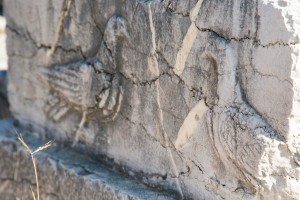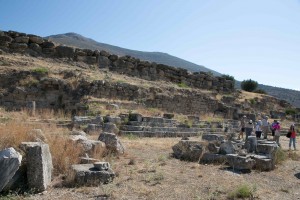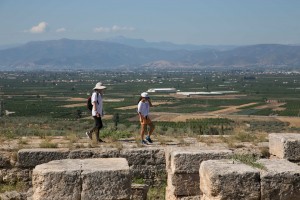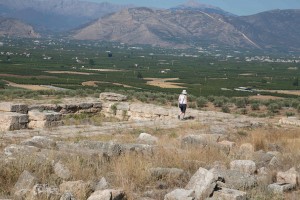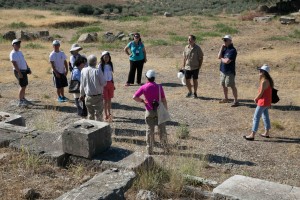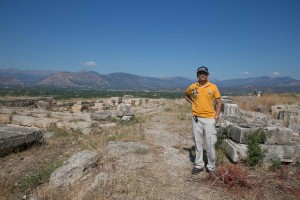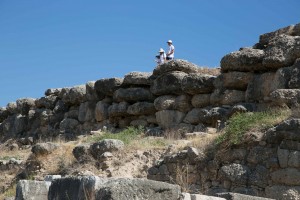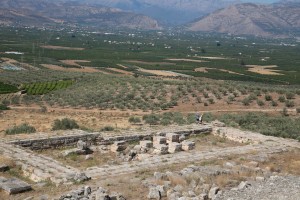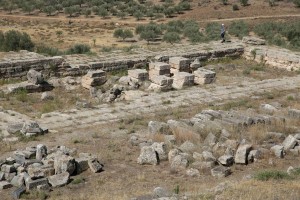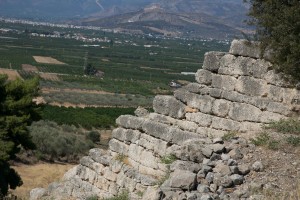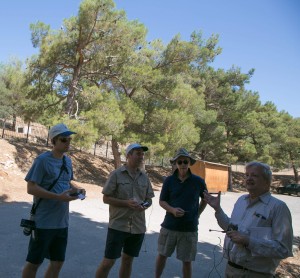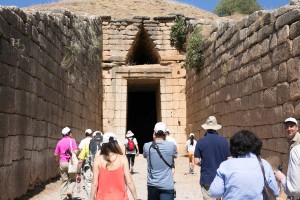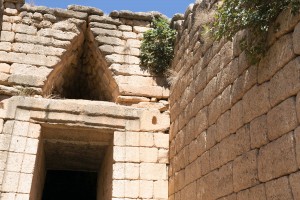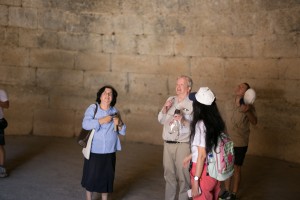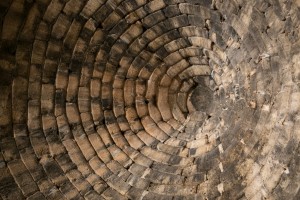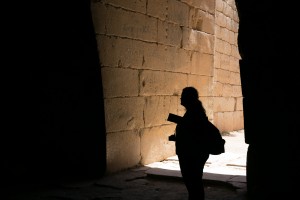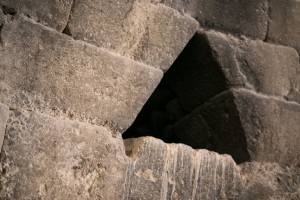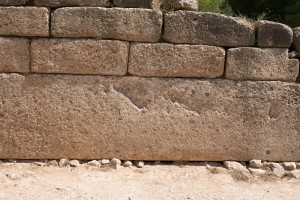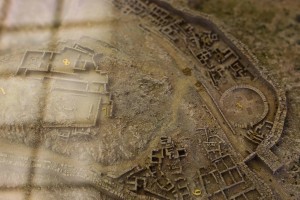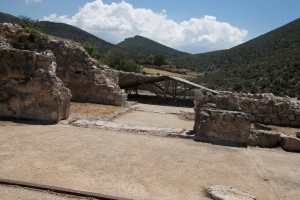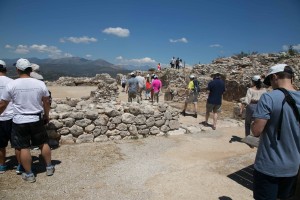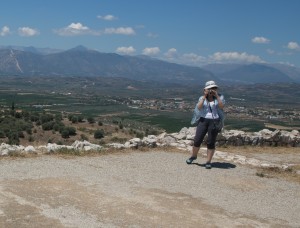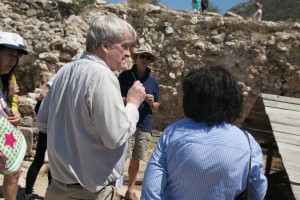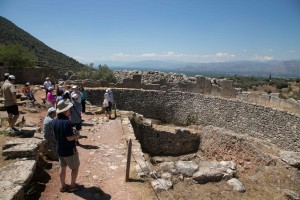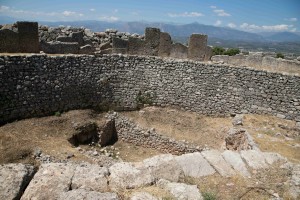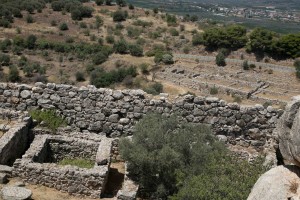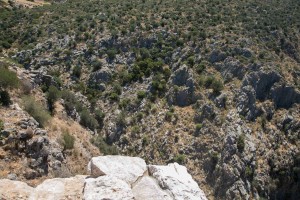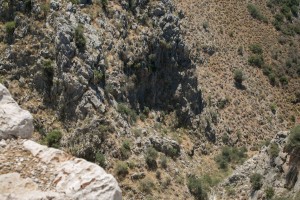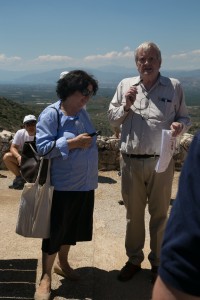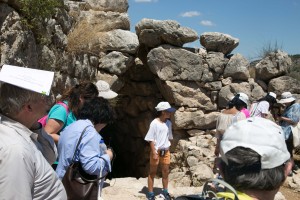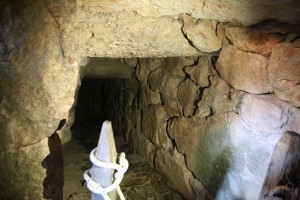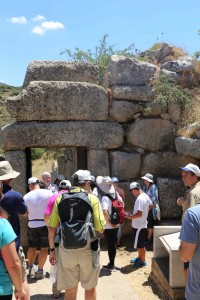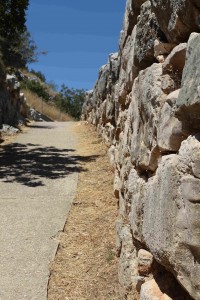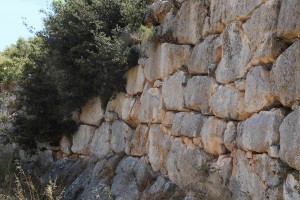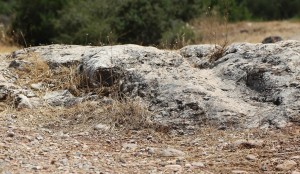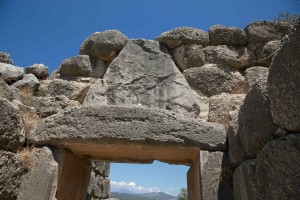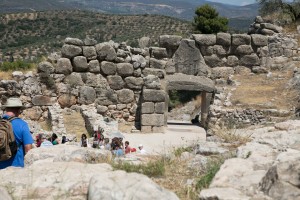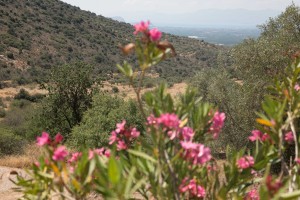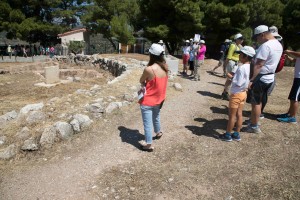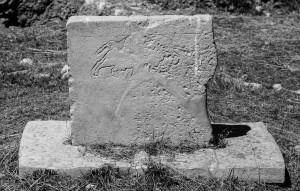2016.06.24 | By Gregory Nagy

§0. Introduction
During the eight full days of contact time for myself and the participants of a Harvard travel-study program, 2016.06.10–18 (who are all listed at the conclusion of my posting for 2016.06.16), I tried each day to focus on things to see—or at least to note if they cannot be seen—at each ancient site we visited. In cases where we visited a museum adjoining the site, I would offer a separate list of three things to see. Wherever it was possible, I used as my primary ancient source the reportage of the ancient traveler Pausanias, who flourished in the second century CE and whose Greek text is translated into English at a site entitled A Pausanias Reader in Progress. At that site, the original English translation of W. H. S. Jones and H. A. Ormerod (1918) is being gradually replaced by my own translation, and I include as well a variety of notes commenting on what Pausanias has to say.
2016.06.11, Saturday [compare 2016.03.15, Tuesday]
§1[= §6]. The sacred space of Hērā[1]
§1[=6].1. Three points to note:
§1[=6].1A. The foundations of the classical temple of Hērā, as pictured in the posting of Classical Inquiries for 2016.03.16.
§1[=6].1B. The plain of Argos, as you look down from the elevation where the classical temple was situated.


§1[=6].1C. The foundations of earlier buildings at the Hēraion or ‘sacred space of Hērā’, as you look further up from the elevation where the classical temple was situated.
§1[=6].2. With reference to all three of the points that I have just listed, I now quote the relevant reportage of Pausanias:
[2.17.1] Fifteen stadium-lengths distant from Mycenae is on the left the Hēraion. Alongside the road flows a rivulet called ‘the water that makes-free’ [hudōr eleutherion]. The women who attend the sacred space [hieron] use it [= the water] in purifications [katharsia] and for sacrifices [thusiai] that are mystical [apo-rrhētoi]. The sacred space [hieron] itself is on a lower part of Euboea. Euboea is the name they give to the hill here, saying that Asterion the river had three daughters, Euboea, Prosymna, and Akraia, and that they were nurses [trophoi] of Hērā.
[2.17.2] The hill opposite the Hēraion they name after Akraia, while the environs of the sacred space [hieron] they name after Euboea, and, further, the land beneath the Hēraion they name after Prosymna. This Asterion flows above the Hēraion, and falling into a cleft disappears. On its banks grows a plant, which also is called asterion. They offer the plant itself to Hērā, and from its leaves they weave garlands [stephanoi] for her.
[2.17.3] It is said that the architect of the temple [nāos] was Eupolemos, an Argive. The sculptures carved above the columns [kiones] refer not only to the birth [genesis] of Zeus and the battle between the gods and the giants but also to the Trojan war and the capture of Ilion. Before the entrance stand statues [andriantes] of women who have been priestesses [hiereiai] of Hērā and of various heroes [hērōes], including Orestes. I say it this way because the statue that has an inscription on it claiming that it represents the Emperor Augustus is really, they say, the statue of Orestes. In the front-part-of-the temple [pro-nāos] are on the one side ancient statues [agalmata] of the Graces [Kharites], and on the right the couch [klinē] of Hērā and a votive offering [anathēma], that is, the shield [aspis] that Menelaos once took from Euphorbos at Troy.
[2.17.4] The statue [agalma] of Hērā is seated on a throne [thronos]; it [= the statue] is huge in size, made of gold and ivory, and is a work of Polycleitus. She is wearing [on her head] a garland [stephanos] that features Graces [Kharites] and Seasons [Hōrai] worked upon it, and in one hand she holds a pomegranate while in the other a scepter [skēptron]. About the pomegranate… I must let go of this subject, since its story [logos] is somewhat mystical [apo-rrhētos].[2] The presence of a cuckoo seated on the scepter [skēptron] they explain by telling how, when Zeus lusted [erân] for Hērā as virgin [parthenos], he changed himself into this bird, and she caught it to be her plaything [paignion]. This story [logos] and similar things said about the gods I write down without accepting [apodekhesthai] them, but I write them down nevertheless.
[2.17.5] By the side of Hērā stands what is said to be a statue [agalma] of Hēbē fashioned by Naukydes; it, too, is of ivory and gold. By its side is an old statue [agalma] of Hērā on a pillar [kiōn]. The oldest statue is made of wild-pear wood, and was dedicated in Tiryns by Peirasos son of Argos, and when the Argives destroyed Tiryns[3] they carried it away to the Hēraion. I myself saw it, a small, seated statue [agalma].
[2.17.6] Of the votive offerings [anathēmata] the following are worth speaking-about [logos]. There is an altar [bōmos] upon which is worked in relief the legendary [legomenon] wedding of Hēbē and Hēraklēs. This is of silver, but the peacock dedicated by the Emperor Hadrian is of gold and gleaming stones. He dedicated it because they hold the bird to be sacred to Hērā. Also deposited here are a golden garland [stephanos] and a purple robe [peplos], offerings [anathēmata] of Nero.
Pausanias 2.17.1–6


§2[=7]. Mycenae[4]
§2[=7].1. Three points to note:
§2[=7].1A. The so-called Treasury of Atreus.
§2[=7].1B The Lion Gate, leading up to the top of the citadel.


§2[=7].1C. The Megaron at the top of the citadel.
§2[=7].2. With reference to all three of the points that I have just listed, I now quote the relevant reportage of Pausanias:
[2.16.5] It was envy that caused the Argives to destroy Mycenae. For at the time of the Persian invasion the Argives made-no-move [hēsukhazein], but the Mycenaeans sent eighty men to Thermopylae who shared in the achievement [ergon] of the Lacedaemonians. This act-of-eagerness-for-distinction [philo-tīmēma] brought ruin upon them by aggravating the Argives. There still remain, however, parts of the circumference-wall [peribolos], including the gate [pulē] on top of which stand lions. These [walls], too, are said to be the work [erga] of the Cyclopes, who made for Proitos the [circumference-] wall [teikhos] at Tiryns.
[2.16.6] Inside the ruins [ereipia] of Mycenae is a spring [krēnē] called Perseiā; there are also underground chambers [hupo-gaia oikodomēmata] of Atreus and his offspring [paides], in which were stored the treasuries [thēsauroi] of their possessions. The tomb [taphos] of Atreus is there, along with the tombs of those who, besides Agamemnon, returned with him from Troy and were slaughtered by Aigisthos after they had been wined and dined by him at a banquet. As for the tomb [mnēma] of Cassandra [Kassandrā], there is a rival claim to it by the Lacedaemonians who dwell [oikeîn] in the vicinity of Amyklai. There is [at Mycenae] another tomb [mnēma] [besides the tombs in the Treasury of Atreus] that specifically belongs to Agamemnon, and there is also another tomb belonging to Eurymedon his charioteer, while still another one is shared by Teledāmos and Pelops, twin sons, they say, of Cassandra,
[2.16.7] whom while they were still children [nēpioi] Aigisthos slaughtered after he slaughtered their parents. As for Electra… Orestes married her off to Pylades, and Hellanicus [FGH 4 F 155] adds that the children of Pylades by Electra were Medon and Strophios. Clytemnestra and Aigisthos were buried at some little distance outside of the [circumference-] wall [teikhos].[5] They were thought unworthy of a place inside it [= the circumference-wall], which is where Agamemnon himself and those who were slaughtered with him had been placed.
Pausanias 2.16.5–7


§3[=8]. The Museum at Mycenae
§3[=8].1. Three points to note:
§3[=8].1A. A fresco painting that shows a goddess standing below ground-level, holding handfuls of wheat in each hand.
§3[=8].1B. A Linear B tablet, on which we see a reference, in the first line, with regard to a divine recipient of an offering: si-to-po-ti-ni-ja (written in the Linear B syllabary), to be transliterated as sītopotniāi (or possibly sītōn potniāi) and to be interpreted as ‘for the lady [potnia] of wheat [sīta]’.
§3[=8].1C. A plaque representing the cartouche of the Egyptian pharaoh Amenophis III. It appears that an Egyptian emissary had given it as a gift to the rulers of Mycenae. As our friend Eleni Palaiologou pointed out to us on the occasion of our visit to the Museum, this plaque was used as a foundation deposit.






2016.06.12, Sunday
§4. The Place of the Ram, near Mycenae
This visit is written up in the posting for Classical Inquiries 2016.06.16.
2016.06.13, Monday [travel from Nafplio to Olympia]
2016.06.14, Tuesday
§5. Olympia
On July 14, 2016, Classical Inquiries will publish my write-up on Olympia, with three focus points and newly revised translations from Pausanias related to the site.
2016.06.15, Wednesday [compare 2016.03.17, Thursday]
§6[=12]. Delphi
§6[=12].1. Three points to note:
§6[=12].1A. The spring of Castalia. Pausanias has this to say about this spring, which is described in other sources as sacred to the Muses:
[10.8.9] Going up from the gymnasium along the way to the sacred space [hieron] [of Apollo] you reach, on the right of the way, the water of Castalia [Kastalia], which is sweet to drink and pleasant to bathe in. Some say that the spring [pēgē] was named after a native [epikhōrios] woman, others after a man called Castalius [Kastalios]. But Panyassis son of Polyarkhos, who composed epic verses [epē] about Hēraklēs, says that Castalia was a daughter of Akhelōos. So, about Hēraklēs he [= Panyassis] says:
Crossing with swift feet snowy Parnassus | he reached the immortalizing [ambroton] water of Castalia, daughter of Akhelōos.
[10.8.10] I have heard another account, that the water was a gift to Castalia from the river Kephisos. That is the way Alcaeus has it in his prelude [prooimion] to Apollo. There is confirmation from the Lilaeans, who on certain specified days have the custom [nomizein] of throwing into the spring of the river Kephisos cakes of-the-district [epi-khōria] and other things, and it is said that these reappear in Castalia.
Pausanias 10.8.9–10
§6[=12].1B. The Serpent Column. A replica now stands where the original monument had been placed, in front of the east entrance to the Temple of Apollo. The centerpiece of the monument was a column around which a bronze serpent is shown coiling all the way to the top, culminating in three bronze serpentine heads that hold up a golden tripod. After the battle of Plataea in 479 BCE, the Greeks celebrated their victory over the invading forces of the Persian Empire by commissioning this Serpent Column and installing it at Delphi at precisely the spot where the replica stands today. The replica shows only the coiling serpent, not the three heads—nor the golden tripod. In 324 CE, the Emperor Constantine I arranged for the original Serpent Column to be removed from Delphi and relocated in Constantinople at the Hippodrome, where it remains to this day. The replica in Delphi, which I mentioned a moment ago, shows what remains of the Serpent Column as it survives in its relocated home at the Hippodrome in Istanbul today. Pausanias saw the original Serpent Column when he visited Delphi, and he has this to say about it:
[10.13.9] The Greeks in common [en koinōi] dedicated from the spoils resulting from their deed [of victory] at Plataea a gold tripod set on top of a bronze serpent [drakōn]. The bronze part of the offering was still preserved [sōon] in my time, but the leaders of Phokis did not leave the gold as they did the bronze.
Pausanias 10.13.9
§6[=12].1C. The foundations of the Temple of Apollo: the view from up above, as you walk past the Theater. Pausanias has this to say about the inside of the nāos or ‘temple’ itself:
[10.24.4] [[. . .]] Here [inside the temple] you may behold the hearth [hestiā] on which the priest of Apollo killed Neoptolemos, the son of Achilles. The things concerning the end of Neoptolemos I have told elsewhere.[6]
[10.24.5] Not far from the hearth [hestiā] has been dedicated a chair [thronos] of Pindar. The chair is of iron, and on it they say Pindar sat whenever he came to Delphi, and there composed his songs to Apollo. Into the innermost part of the temple [nāos] only a few may pass, and there is dedicated in it another statue [agalma] of Apollo, made of gold.
[10.24.6] Leaving the temple [nāos] and turning to the left, you will come to an enclosure [peribolos] in which is the tomb [taphos] of Neoptolemos son of Achilles. Every year, the Delphians sacrifice [enagizein] to him as to a hero. Coming further up from the tomb [mnēma], you reach a stone [lithos] of no large size. Over it every day they pour olive oil, and at each festival [heortē], they place on it unworked wool. There is also an opinion about this stone, that it was given to Kronos instead of his child and that Kronos vomited it up again.
[10.24.7] Returning to the temple [nāos] after seeing the stone [lithos], you come to the spring [pēgē] called Kassotis. Next to it is a wall of no great size, and the ascent to the spring [pēgē] is through the wall. It is said that the water of this Kassotis sinks under the ground and, inside the inner sanctum [aduton] of the god, it causes the women there to become inspired [mantikai]. She [= Kassotis] who gave her name to the spring [krēnē] is said to have been one of the nymphs [numphai] of Parnassus.
Pausanias 10.24.4–7
§7[=13]. The Museum at Delphi
§7[=13]. Three points to note:
§7[=13]A. The statues of Kleobis and Biton. In my book The Ancient Greek Hero in 24 Hours 13§§11–22 (see also 11§17), I quote and analyze the narrative in Herodotus 1.31.1–5, which ends with the report that the people of Argos commissioned statues of Kleobis and Biton to be set up at Delphi. And that is exactly where the two statues were unearthed in modern times.


§7[=13]B. The Navel of the Earth. In the Hesiodic Theogony: at one point in the narrative, the goddess Rhea tricks Kronos into swallowing a stone that she substitutes for the newborn god Zeus (verses 485–491). This stone, along with the divine siblings of Zeus whom Kronos had already swallowed, is then vomited up by Kronos after he is overthrown by Zeus (497). The victorious Zeus then deposits this stone for display as a cult object at Delphi (498–500). Pausanias has this to say about the Omphalos or ‘Navel’:
[10.16.3] What is called the Omphalos [‘Navel’] by the Delphians is made of white marble, and is said by the Delphians to be the center of all the earth. Pindar[7] in one of his odes supports their view.
Pausanias 10.16.3


7[=13]C. The Charioteer of Delphi. The limestone base of this exquisite bronze statue indicates that it was dedicated by Polyzalos, who was tyrant of the Sicilian city of Gela in the early fifth century BCE. Evidently Polyzalos had sponsored the winning chariot team of horses driven by our charioteer in the Pythian Games of 478 or 474 BCE. Later on, sometime in the fourth century BCE, the statue and the rest of the statuary that belonged with it (including statues of the four horses that drew the chariot) was accidentally buried in a rockfall. This accident helped preserve the statue until it was unearthed in modern times. But it also hid this masterpiece from viewing by Pausanias, who visited Delphi in the second century CE. He never saw it. For a brilliant article about statues of charioteers, I cite Bell 1995, listed in the Bibliography.
2016.06.16, Thursday [compare 2016.06.13, Sunday]
§8[=1]. The Acropolis of Athens
§8[=1].0.1. Proceeding upward to the Propylaea, which is the grand western entrance that leads into the upper ground of the Acropolis, we move along what was once a ramp instead of a set of stone steps. At one point, to our right, we can look through a “window” into the Mycenaean world: it is an opening in the fifth-century wall. Such openings were constructed deliberately to reveal the inner layer of “Cyclopean” wall-construction dating from a millennium earlier. As we proceed through the grand gateway of the Propylaea, we would see facing us, if it were still there, a gigantic bronze statue of the goddess Athena, made by the renowned sculptor Pheidias. I drew attention to the description by Pausanias:
In addition to the works of art I have mentioned, there are two tithes [dekatai] dedicated by the Athenians after wars.[8] There is first a bronze statue [agalma] of Athena, tithe [dekatē] from the [victory over the] Persians who landed at Marathon. It is the work [tekhnē] of Pheidias. [[. . .]] The point of the spear of this Athena and the crest of her helmet are already visible to those sailing to Athens as they pass by Cape Sounion.[9]
Pausanias 1.28.2
§8[=1].1. Three points to note, once we pass through the Propylaea and have finally reached the grounds of the Acropolis:
§8[=1].1A. As we stand at the southwest corner of the Parthenon and look upward, we can see looming there some fragmentary horizontal stonework that marks the location of the Panathenaic Frieze. This frieze, created in the 440s BCE during the long-term building program that culminated in the Parthenon, was a masterpiece of relief sculpture that originally wrapped itself all the way around the inside of the Parthenon. I will have more to say about this masterpiece in a few minutes. For now, however, I simply note that the small part of the Panathenaic Frieze that we see from down below as we now look up at the southwest corner of the Parthenon is merely a copy, but it gives modern viewers a reasonable idea of what could be seen by ancient viewers in the Age of Pheidias, who supervised the massive building program initiated by Pericles for the Athenian Acropolis. The original stonework that is represented by the fragmentary copy that we see up above from down below—as well as the rest of the stonework that survives in Athens—can be viewed in the Acropolis Museum, on which I have more to say in a few minutes.
§8[=1].1B. Starting to walk counterclockwise around the Parthenon, we marvel at the prodigious architecture as we look to the left (including a view of the earlier layers of “Cyclopean” wall construction) and, as we keep walking, we now look all the way down from the walls to the right and see below us the foundations of the Theater of Dionysus, to the left of which used to stand the Odeum (ōideion) of Pericles. The Theater was the primary venue for premiere performances of the tragedies composed by Aeschylus, Sophocles, and Euripides. As for the Odeum, as I argue, it was the primary venue for performances of the Homeric Iliad and Odyssey at Athens in the era of Pericles.[10]
§8[=1].1C. We now round the southeast corner of the Parthenon and find ourselves facing the east side of the Parthenon. I will have more to say in a minute about this stopping-point. But let me first describe what happens after this point. We walk toward the north of the Acropolis, heading for a building-complex known as the Erechtheum (Erekhtheion). On our way, we pass by the poorly-identifiable remains of the Old Temple of Athena, and now we descend the modern steps leading down to a lower level, where we confront the Temple of Poseidon. A stylized hole in the floor of this temple marks the place where a small pool fed by a salt-water spring once existed. In terms of the myths and rituals associated with this place, the pool was created when Poseidon violently struck the ground with his trident, and a mark of his divine action from above is a stylized hole in the roof, diagonally corresponding to the stylized hole in the floor.
§8[=1].2. Before I listed the three points that I have just now reviewed, I had mentioned a gigantic bronze statue of Athena, made by Pheidias, which is no longer to be seen—but which was once upon a time the very first sight to dazzle visitors as they entered from the Propylaea into the high ground of the Acropolis. Now I must mention an even more dazzling sight: it is the gigantic gold-and-ivory statue of Athena, also made by Pheidias, which had once been housed inside the Parthenon. As in the case of the bronze Athena, this gold-and-ivory Athena, one of the world’s greatest marvels of classical art, is no longer to be seen. To have lost the sight of this dazzling statue is arguably one of the greatest losses of civilization. When our travel-study group was standing in front of the east side of the Parthenon, I invited us to imagine the spectacular moment, repeated every day at dawn, when the attendants of Athena opened her temple’s massive wooden door—and the first light of day would now be streaming into the inner darkness, gradually illuminating the gold-and-ivory figure of the goddess of Athens. This dazzling sight of Athena evidently made a deep impression on Pausanias, who describes what he saw in words that I quote here:
As you enter the temple that they name the Parthenon, all the sculptures you see on what is called the [east] pediment [aetos] show the birth of Athena, but those on the rear [= west] pediment show the contest between Athena and Poseidon over the ownership of the land [of Athens]. The statue [agalma] itself is made of ivory and gold. On the middle of her helmet is placed a likeness [eikōn] of the Sphinx [[. . .]] and on either side of the helmet are griffins [grūpes] in relief. [[. . .]] The statue of Athena is standing, with a tunic [khitōn] reaching to the feet, and on her breast the head of Medusa is worked in ivory. She holds a statue of Nike about four cubits high, and in the other hand a spear; at her feet lies a shield and near the spear is a serpent [drakōn]. This serpent [drakōn] would be Erikhthonios.
Pausanias 1.24.5–7
§8[=1].3. What happened to the statue of Athena? In my book Masterpieces of Metonymy, I quote and analyze an ancient report that tells all about it.[11] The report starts with a man named Proclus, a famed neo-Platonic philosopher who lived in the fifth century CE, and the reporter is his faithful student, named Marinus, who composed a work known as The Life of Proclus. As we read in the report of Marinus (Life of Proclus 30), Proclus experienced in a special way the fate of the statue of Athena. This spectacular statue, which had been meant to dazzle for all eternity a never-ending stream of daily visitors approaching the Parthenon to get a glimpse of the goddess, was unceremoniously carted off by Christian zealots—never to be seen again.[12] In the report of Marinus, this catastrophe for civilization is linked with an epiphany experienced by Proclus:
How dear [pros-philēs] he [= Proclus] was to the goddess of philosophy [= Athena] was amply demonstrated by the fact that he chose for himself a philosophical life. But, even more than that, the goddess herself showed it when her statue, which had been until this time situated in the Parthenon, was removed by those [= the Christians] who move [kineîn] things that must not be moved [akinēta]. In a dream [onar], he [= Proclus] seemed to be seeing a woman of great beauty coming toward him and announcing to him that he must, as quickly as possible, get his home [oikiā] ready for her, “because the Athenian Lady wishes to live with you in your home [para soi].”
Marinus Life of Proclus 30
§8[=1].4. Goddesses have a way of talking like that. Even when they speak in the first person, they will refer to themselves in the third person. A classic example is the wording of Aphrodite in the Hippolytus of Euripides (verse 33). As we consider further the story about the epiphany of the goddess Athena, appearing as she does to Proclus in a dream, I need to highlight the fact that the goddess here is following up on an earlier epiphany experienced by the philosopher. As we are about to read in a passage extracted from an earlier point in The Life of Proclus, Athena appeared to the philosopher already in his youth, when he was still living in Constantinople. In this earlier epiphany, the goddess had invited young Proclus to embrace philosophy as his lifelong passion. I will now quote the wording of this story, calling attention in advance to a striking detail. As we are about to see, this epiphany is meant to explain why the philosopher developed a special feeling of intimacy with Athena as the goddess of wisdom, as the patroness of philosophy. Here, then, is the wording, which explains why Athena cared so much for Proclus from the very start:
You see, she [= Athena] appeared [phainesthai] to him in a dream [onar] and summoned him to a life of philosophy. And I think that this is why he experienced such great familiarity [oikeiotēs] with the goddess. As a result, he especially adored her and was observant of her rituals [orgia] with more of a passionate intensity of divine possession [enthousiastikōteron].
Marinus Life of Proclus 6
§8[=1].5. The intimacy that Proclus felt he shared with the goddess Athena is expressed here by the word oikeiotēs, which I translate as ‘familiarity’. To be familiar with something or someone is to be at home with that something or someone. After all, the adjective oikeio- is derived from the noun oikos, meaning ‘home’; a related noun is oikiā, likewise meaning ‘home’, which is used in the text I quoted earlier (Marinus Life of Proclus 30) when Athena at the moment of her epiphany tells Proclus that he must, as quickly as possible, get his oikiā ‘home’ ready for her. Here I return to the story about the removal of the statue of Athena from her home in the Parthenon on top of the Acropolis of Athens. As we saw in this story, Proclus experiences the sensory fusion of both seeing and hearing the goddess at the very moment when her statue is being permanently removed from sight. As her statue disappears forever, the goddess re-appears to Proclus in a final epiphany that recalls the primal epiphany that had bonded the philosopher to her forever. Though the statue of the goddess is gone, removed from her home in the Parthenon, the goddess of philosophy now finds for herself a new home in the heart of the philosopher who will love her forever and ever.
§8.6. Besides the points A B C that I have emphasized in §8.1, I shared with my fellow travelers on 2016.06.16 a check-list of twelve “views,” some of which I have already noted in §8.1–5 above:
- A view of the “window” on the Cyclopean walls of Athens. See §8.0.1 above.
- A view of the Pnyx, as you turn around and look West when you enter the Propylaea
- A view of the spot where once stood the colossal bronze statue of Athena. See §8.0.1 above.
- A view of a replica of a part of the Parthenon Frieze as you face the southwest corner of the Parthenon and look up from ground level. See §8.1A.
- A more extensive view of the Cyclopean wall of Mycenaean-era Athens as you round the southwest corner of the Parthenon and look to your left. See §8.1B.
- A view of the ruins of the Theater of Dionysus—and of the spot next to it were the Odeum of Pericles once stood. See §8.1B.
- A view of the East entrance to the Parthenon. See §8.1C.
- A view of the stylized hole in the ceiling though which the trident of Poseidon crashed into the Temple of Poseidon. See §8.1C.
- A view of the stylized hole in the floor where the trident landed at the Temple of Poseidon.
- A view of the spot where the olive tree of Athena once grew—now replaced by a new olive tree.
- A view of the cave of the Furies a.k.a. Erīnues a.k.a. Eumenides; this cave is located at the foot of the Areopagus or ‘Hill of Ares’
- A view of the top of the Areopagus, where the Apostle Paul once delivered a speech to the Athenians.
§9[=4]. The Acropolis Museum
§9[=4].0. We start at the southwest corner of the display showing the Parthenon Frieze, on the top floor of the Acropolis Museum. The Frieze and even the floor that contains the Frieze are aligned exactly with the Parthenon, which we can see looming up above on the Acropolis as we look out the window of the Museum. What do I mean by “alignment” here? Simply this: the north-south-east-west coordinates of the Frieze match exactly the original coordinates of the Parthenon itself. And the Acropolis Museum, situated on street-level to the south of the Acropolis looming above it, recreates in scale the entire Frieze as it had existed before its stonework was taken down in two phases. The first phase was the violent sawing-off that took place at the initiative of Thomas Bruce, also known as Lord Elgin, who dismantled and hauled off major portions of the Frieze along with other priceless artifacts within the years 1801 and 1812. What Elgin took down is now housed in the British Museum. The second phase was the scientifically-supervised removal and transfer of the remaining portions of the Frieze to their existing home on the top floor of the Acropolis Museum. These portions, now protected from the ravages of air pollution on the outside, are awaiting a hoped-for reintegration with their counterparts in the British Museum.
§9[=4].1. Three points to note:
§9[=4].1A. For the first point, I start at the southwest corner of the Parthenon Frieze: at this corner, the actions that are represented by the sculpted figures are split into two perspectives for viewing a parallel movement of exquisitely sculpted figures headed toward one single destination, which is the center of the east side of the Frieze. On the right side, the movement rounds the southwest corner and then heads for the East along the southern side of the Frieze. On the left side, the movement has a longer way to go: there are figures that move along the west side heading from South to North before rounding the northwest corner and then joining the left-hand side of the overall movement as it heads for the East along the northern side of the Frieze. What is all this “movement,” as I refer to it here? Primarily, it is a procession. In fact, it is the ultimate procession of the Athenians, generally known today as the Panathenaic Procession because it occurs at the Great Panathenaic Festival, celebrated every four years to honor the primary divinity of Athens, the goddess Athena.
§9[=4].1B. For the second point, I choose the blocks on the north side of the Panathenaic Frieze that represent scenes of apobatic chariot racing (blocks 11–29). What I mean is this: an armed athlete known as an apobatēs, which means literally, ‘the one who steps off’, is getting ready to jump off the platform of a speeding chariot driven by a fellow athlete, who is the charioteer. Although the Frieze represents primarily the Panathenaic Procession, not all of the events depicted in the relief sculptures of the frieze involve the actual procession. Although as I just said the primary event is the procession itself, the frieze also represents other events that were aspects of the Great Panathenaic Festival, including various forms of athletic events. A case in point is a set of depictions centering on apobatic chariot racing. As we know from a variety of sources, this kind of chariot racing was a major athletic event at the celebration of the Great Panathenaic Festival. Here is what I have to say about apobatic chariot racing at this festival in my book The Ancient Greek Hero in 24 Hours (7b§§3–4):
[H24H 7b§3.] In the relief sculptures of the Panathenaic Frieze of the Parthenon, we see twenty-one apobatic chariot teams on display, with eleven chariots featured on the north side (North XI–XXIX) and ten on the south side (South XXV–XXXV); in each case, the chariot is shown with four horses, a driver, and an apobatēs, who is wearing a helmet and a shield. The apobatai are shown in a variety of poses: stepping into the chariot, riding in the chariot, stepping out of the chariot, and running alongside the chariot; in two cases, the apobatai are evidently wearing a full set of armor.
[H24H 7b§4.] What makes the feat of leaping into or out of a speeding chariot so commandingly distinctive is that the apobatēs executes his leap in the mode of an epic warrior. While the fellow athlete who drives the chariot is standing on the right side of the vehicle and wearing the full-length gown of a charioteer, the apobatēs standing on the left side wears a helmet and carries a shield. I focus here on the critical moment when the apobatic athlete, holding on to the shield with his left hand, starts loosening the grip of his right hand on the rail of the speeding chariot and then suddenly leaps to the ground. Weighted down by all this armor, the apobatēs must hit the ground running as he lands on his feet in his high-speed leap from the platform of his chariot. If his run is not broken in a fall, he continues to run down the length of the racecourse in competition with the other running apobatai, who have made their own leaps from their own chariots.
§9[=4].1C. For the third point, I choose a scene depicted at the center of the east side of the Panathenaic Frieze. Here we have reached the central scene in the wrap-around relief sculptures of the Frieze. I analyze this scene in Part Three of my book Masterpieces of Metonymy, and I provide here a link to the full text of my analysis, which goes from 3§1 all the way to 3§102. To read this text in its entirety, however, would take about a full hour, and I appreciate the fact that some of my readers will not have the time to go through my whole argumentation, step by step. One short-cut would be to read only 3§§32–102. An even shorter alternative would be to go from 3§32 only as far as 3§60. And the shortest alternative of them all would be to read only the epitome that follows, which takes us from 3§32 only as far as 3§39:
[MoM 3§32.] The central scene of the Parthenon Frieze refers to an event that took place in the Panathenaic Procession. The sacred robe of Athena, called the Peplos, was paraded along the Sacred Way for all to see, and then it was finally presented to the goddess at the climax of the procession. That Peplos is the folded robe that we see pictured in the relief sculptures of Block 5 of the east side of the Parthenon Frieze. In terms of my argumentation, this robe is the one and the same sacred Peplos of Athena. Here is a line drawing of the scene:


[MoM 3§33.] This relief sculpture is carved into a block (often called instead a “slab”) occupying the most prominent space of the Parthenon Frieze. This block, “Block 5,” features a sculpted scene picturing five human figures in all. The two figures that I show in the line drawing are situated on the right side of Block 5, and there are also three other figures on the left side. Framing both sides of Block 5 are the sculpted figures of seated gods, larger in size than the five humans. On our left, in Block 4, the gods Zeus and Hērā frame these humans, while in Block 6, on our right, the framing gods are Athena and Hephaistos.
[MoM 3§34.] One expert, Jennifer Neils, has aptly described the scene picturing the five human figures in Block 5 as “the high point” of the overall narrative of the Parthenon Frieze, “framed between the central columns of the temple façade,”[13] and “[i]t was here that the design [of the frieze] must have begun and for which an exceptionally long block [= Block 5] was ordered, quarried, and set into place.”[14] The expert whom I have just quoted about Block 5 goes on to describe the narrative sculpted into this “exceptionally long block” as “important enough to dictate the layout of the entire frieze” into “two processional files” that converge on this narrative. When she says “two processional files” in her description, she makes it clear that she has in mind the overall narrative of the Parthenon Frieze, which she sees as a representation of the Panathenaic Procession at the festival of the Panathenaia.
[MoM 3§35.] I have already noted the importance of this procession as the setting for the ritual presentation of the Peplos. I have more to say about the ritual presentation, as experts call it, but for now I concentrate on the Panathenaic Procession itself, as represented on the Parthenon Frieze.
[MoM 3§36.] In emphasizing the importance of the narrative carved into Block 5 at the east side of the Frieze, Neils is saying that the overall representation of the Panathenaic Procession converges on this one single narrative. In her wording, as we just saw, the Procession splits into “two processional files” proceeding eastward from the north and from the south sides of the Parthenon Frieze and then converging at the “high point” featuring the five human figures carved into Block 5 of the east side.
[MoM 3§37.] But the narrative of this “high point” is problematic, since experts have till now been unable to shape a consensus about what it all means. From the standpoint of a casual viewer’s first impression, the five human figures of Block 5 could understandably be described as “this unimpressive quintet.”[15] But I think that all five of these human figures are in fact all-important.
[MoM 3§38.] To back up this line of thinking, I start by concentrating on the two human figures positioned on the right side of Block 5, as shown in the line drawing. These two figures are pictured here in the act of holding on to a fabric as they face one another, and I agree with those who think that the two of them are participating in a ritualized act[16]—an act that I have been describing up to now as the presentation of the Peplos.
[MoM 3§39.] While I agree with the idea that this scene, as sculpted into Block 5 of the east side of the Parthenon Frieze, is picturing some kind of a ritual that features the presenting of the Peplos to Athena, I disagree with the further idea that this scene describes the ritual of such a presentation as it took place in the era when the Panathenaic Frieze was sculpted. Instead, I argue that the presentation of the Peplos in Block 5 follows the pattern of a myth that aetiologizes this ritual, and this argumentation takes me from 3§40 all the way to 3§102 in Masterpieces of Metonymy. And who are the two figures who are participating in such a myth? As we can see from the line drawing that I just showed, the figure on our left is a male adult, and the figure on our right is an adolescent, shorter than the corresponding adult by well over a head’s length. The gender of the adolescent is no longer clearly distinguishable, partly because the surface of the relief sculpture has been so massively eroded, but I argue in 3§§40–102 that this figure is female. I will leave it for the reader to decide whether or not to look up the step-by-step argumentation that I present there.
§10[=2]. The Agora of Athens
§10[=2].1. Three points to note:
§10[=2].1A. The Altar of the Twelve Gods. This spot marks the place where the twelve Olympian gods were worshipped by the Athenians in an era when their city’s affairs of state were controlled by the Peisistratidai, an aristocratic lineage of political strongmen who were retrospectively labeled ‘tyrants’ after they were overthrown in 508/507 BCE by a democratic régime founded by Cleisthenes, member of a rival aristocratic lineage known as the Alkmaionidai. According to Athenian tradition, this Altar was the centerpoint of the world: to measure the distance of any place from Athens, the starting point had to be this altar. The so-called father of history, Herodotus, was aware of this tradition when he spoke of the distance between the Altar in Athens and the Temple of Zeus in Olympia (2.7.1): in this case, the distance as reported by Herodotus was one thousand five hundred Olympic stadium-lengths minus fifteen. I must add that the theological and political significance of the Altar can be linked to the “politics of Olympus” as reflected in the poetic construct of the twelve Olympian gods in the Homeric Iliad and Odyssey.[17]
§10[=2].1B. The Monument of the Ten Eponymous heroes of the Athenian State. After the democracy was instituted in 508/507 BCE at the initiative of Cleisthenes, the citizens of the Athenian State were originally subdivided into ten phulai (phylai) or ‘subdivisions’ (the translation ‘tribes’, used by some modern historians, is misleading). Each phulē (phyle) or ‘subdivision’ was named after a hero, and that is why the term epōnumos ‘eponymous’ applies: this term indicates that someone is being named after someone who in this case is notionally an ancestor. So, it is as if all the citizens of Athens were derived from civic ancestors stemming from the heroic age. The Monument of the Ten Eponymous Heroes originally featured a marble base upon which stood the bronze statues of the following ten heroes: [1] Erekhtheus, [2] Aigeus father of Theseus, [3] Pandion, [4] Leos son of Orpheus, [5] Akamas son of Theseus, [6] Oineus, [7] Kekrops, [8] Hippothoön, [9] Aias (Ajax), and [10] Antiokhos son of Hēraklēs.
§10[=2].1C. The place where Socrates was forced to drink the hemlock in 399 BCE. I return to what I said about this place in a posting from 2015.03.27, entitled “The last words of Socrates at the place where he died,” which was composed almost exactly one year ago.


§11[=3]. The Agora Museum
§11[=3].1. Three points to note:
§11[=3].1A. There is a display case showing a collection of small vials that must have contained doses of hemlock used for executions approved by the State of Athens. In this case as well, I return to my posting from 2015.03.27, entitled “The last words of Socrates at the place where he died.” The photograph of the display case was taken by Hunt Lambert.


§11[=3].1B. There is a terracotta plaque, dating back to the seventh century BCE or beyond, showing a female figure with the palms of both hands turned seemingly outward, straight at the viewer. Flanking the figure are two serpents: the one on our left is red and the one on our right is blue. The description “snake goddess,” applied to her by some, is not all that helpful.
§11[=3].1C. Outside the Museum, in the portico of the reconstructed “Stoa of Attalos,” there is a relief sculpture on a marble base, dated to the fourth century BCE, showing an “apobatic moment.”
2016.06.17, Friday [compare 2016.03.14, Monday]
§12[=5]. The National Archaeological Museum of Athens
§12[=5].1. Three brief notations for slow reading:
§12[=5].1A. In a vast hall straight ahead as you enter, which houses Mycenaean antiquities, we find at the farther end of this hall a slanted-horizontal display case containing seals and sealings. One seal, found in a Mycenaean tholos tomb at Vapheio near Sparta, shows the image of a man in a long robe who is carrying a fenestrated axe (CMS I.225). This axe is shaped like a capital P with a vertical bar bisecting the semicircle attached to the straight line of the P. In a vertical display case nearby—it is to our right as we face the two posts from the “Treasury of Atreus”—we actually see the fenestrated axe (National Archaeological Museum inventory no. 1870): this object had been buried together with the seal that shows the picture of the man carrying the axe. And the man who is pictured on the seal is the same man who had been buried in the tomb containing both the axe and the seal that shows the man carrying the axe; in fact, the seal was attached to the man’s wrist (Yasur-Landau 2015:141). It has been observed about this axe that, by the time it was buried with its owner in the Mycenaean tomb at Vapheio, it was already “a centuries-old ceremonial weapon,” dating as far back as sometime between the 20th and 18th centuries BCE (Yasur-Landau pp. 139, 146); both the axe and the seal had been acquired from Minoan Crete (Yasur-Landau p. 141).


§12[=5].1B. Backtracking to the entrance to the museum . . . Instead of proceeding straight ahead as you enter the museum, there is an alternative route if you turn left. We find in the very first hall, to our right, a huge Geometric vase known as the Dipylon Amphora. Here is a utensil that has evolved into something so big that it has outgrown its utility as a utensil (in the present case, as an amphora). We focus on the patterns painted on the vase. They show natural figures that are human and animal and floral and so on, surrounded by decorative geometric figures. Represented at a centerpoint of the vase is the human figure of a dead body lying on a bier, surrounded by other human figures who are making gestures of lamentation. The primary gesture centers on the raising of the two arms, pointing them straight up from the elbow. Shown hanging over the bier on which the dead body rests is an expansive fabric, and the painting here represents the pattern-weaving of this fabric in a stylized way. In real pattern-weaving, the patterns woven into a fabric would represent natural figures that are human and animal and floral and so on, surrounded by decorative geometric figures. So, the world that is pictured by way of pattern-weaving matches the world that is pictured by way of Geometric vase-painting. But in the vase-painting here that represents a fabric that would have shown the many varieties of such woven figures, what is shown instead is merely a checkerboard patterning. So, the painting represents the variety of what is seen in a pattern-weave by way of a simple alternation of black and white squares. As for the human figures that are being represented in the paintings on the vase, lozenge-shapes are used for representing parts of the body. For example, the chest of a human figure is represented as an upside-down triangle. In pattern-weaving, such lozenge-shapes are typical in representing parts of the human body. That is why I think that the techniques of painting figures on Geometric vases are modeled on techniques of pattern-weaving figures into fabrics. If my thinking here is valid, then it is fair to say that the art of Geometric pottery-painting, presumably performed by professional men, is modeled in some ways on the art of pattern-weaving, presumably performed by non-professional women.
§12[=5].1C. Further along in a nearby hall is the statue of a girl named Phrasikleia, standing on a base that bears an inscription that tells about the statue. Evidently, the statue and its base were once markers of a tomb. The statue of this girl was buried sometime between 530 and 510 BCE or so, evidently to protect it from destruction or defacement by political enemies of the girl’s aristocratic family. The base of the statue was not buried but survived independently. The statue, once it was buried and thus hidden away, remained undetected for some 2,500 years, until it was finally unearthed in 1972 at a place called Merenda outside the city of Athens. Reunited with its base at the Museum, this statue (inv. no. 4889) represents one of the most exquisite pieces of archaic art, and it preserves most aspects of the artistry that went into its creation, including a wide range of colors. An inscription on the base of the statue tells the story of Phrasikleia:
σεμα Φρασικλειας· | κορε κεκλεσομαι | αιει αντι γαμο | παρα θεον τουτο | λαχοσ᾿ ονομα
This is the marker [sēma] of Phrasikleia. ‘Girl’ [korē] is what I will be called for all time to come. Instead of marriage, I have been fated by the gods to have this name.
(The base of the statue is also inscribed with the name of the sculptor: Aristion of Paros.) The unopened flower that the girl holds in her hand is to be contrasted with the opened flowers, intertwined with flower buds, that we see woven into the garland adorning her hair. Many experts think that the flower she holds forever is a lotus, which closes at night—only to open every morning with the coming of daylight. The name of the girl, Phrasikleia, contains the word kleos, which indicates poetic ‘glory’, and this name ‘points’, as indicated by phrasi-, to an eternal glory that is promised her by the poetry of the inscription whenever its inscribed words are read out loud by a passerby (Svenbro 1988:12–25).
§12.2. I shared with my fellow travelers on 2016.06.17 this check-list of further points of interest to be noted in the Museum:
- As you enter the Museum, to the right, there is a hall featuring Cycladic art. I drew attention to two figurines, placed next to each other in a display case: one figurine represents the player of a string instrument, prototype of the kitharā, while the other represents the player of a wind instrument, prototype of the aulos. These two instruments were the essential accompaniment for most forms of song and dance in the later periods of the second and first millennia BCE and beyond.
- As you enter the Museum, straight ahead is the grand hall containing artifacts from the Mycenaean era. Introducing all the displays are slabs from Grave Circle A of Mycenae, placed in the foreground of the hall. Just as these slabs are now the prime markers for the prestige of the Museum, they used to be prime markers for the prestige of Mycenaean civilization. I noted the hunting scenes depicted on the surfaces of the slabs. Grave Circle A is dated to the sixteenth century BCE.
- I note, in passing, the golden death mask of “Agamemnon””; inside the same display-case are two exquisite daggers that I also note in passing. From here on, I will just say “note,” not “I note.”
- Note the depiction, on a rhyton (#8 in the relevant display-case), of a wartime siege that is evidently cognate with depictions of sieges in the verbal art of Homeric poetry. I speak here of a cognate relationship between the visual arts and the verbal arts. I use the word “cognate” here to indicate that these two forms of art, visual and verbal, are related to each other, yes, but there is no need to suppose that the visual arts are dependent on the verbal arts—or vice versa.
- Note a set of gold-leaf scales (#9 in the relevant display-case) buried along with the bodies of aristocratic women in Shaft Grave III of Grave Circle A of Mycenae. Among the decorations on the gold-leaf “weights” that accompanied the scales were representations of butterflies or moths, the word for which in Classical Greek is psūkhē; other meanings for this word in Classical Greek include ‘breath of life’ or ‘spirit’ or even ‘soul’. Comparing the expression “life hangs in the balance,” I argue for the significance of representing a moth or butterfly as a “weight” to be weighed at the moment of death. There is a cognate idea in Homeric poetry, as in Iliad 22.208–213, where Zeus is weighing on his golden scales the lives of Achilles and Hector, and the technical word for this idea is psūkho-stasiā, meaning ‘weighing of the psūkhē’ on a set of scales.
- Note a particularly large seal-ring on display, featuring a depiction of what archaeologists guardedly describe as a “religious scene.”
- Note the displays of fresco paintings of two figure-eight shields, featuring representations of the natural patterning of spots to be found on the hides of most cows: the shields made from cowhide in the Mycenaean era preserve such natural patterning, and the artistic representations of the cowhide shields transmit naturalistically the same patterning. On the idea of a cowhide shield as an exteriorization of the interior heroic self, you can read about it in Nagy 1990:263–265.
- Note the “Warrior Vase,” dating from the late Mycenaean period, depicting uniformed helmeted warriors heading off to war. Behind them is the figure of a woman with outstretched arms. This gesture signifies the performance of lament.
- A boar’s-tusk-helmet.
§12.3. Here are still further points of interest in the Museum:
- Note in passing the bronze statue of the bearded male figure throwing… a trident? … a thunderbolt?
- Note in passing another relief sculpture representing “the apobatic moment.” Relevant analysis in Classical Inquiries 2016.06.23 at §9.1B. Also at §11.1C.
- Note in passing a relief sculpture showing a warrior mourning himself. He is a “marine,” whose task would have been to fight in hand-to-hand combat by boarding the decks of enemy ships in naval battles. Evidently, this marine had been lost at sea, and now we see him sitting sadly on a headland overlooking the watery blue expanse that will not release his body for a proper burial in Mother Earth. The headland is eerily shaped like the prow of a battleship. And the person who is sitting there dejectedly on that headland is not really a person. Rather, he is a kind of disembodied self who is sadly contemplating the irretrievable loss of his own body at sea.
§12.4. We proceed to the upper floor of the Museum, and I select only a small sampling of the many wonders to be seen here. In this case, I will offer only a minimalist description of each sampling:
- Geometric vase featuring an image of a kitharā-player. #15842.
- Geometric vase featuring an image of a chariot race. #806.
- Geometric vase featuring an image of a funerary carriage. #990.
- Geometric vase featuring an image of a “mistress of animals.” The date: around 675–650 BCE. #355.
- On a terracotta decoration for a temple of Apollo, we see a painting that shows the images of Aēdōn and Khelidōn, two doomed sisters in a myth about their tragic transformation into a nightingale and a swallow. In this fragmentary painting, we see an inscription that labels the sister on the right as ΧΕΛΙΔFON, which means ‘swallow’ (khelidōn). In another version of the myth, the sisters are known as Procne and Philomela. For an analysis of this myth, see my posting for 2016.01.07 §§19–23.
- Wooden panels, dating from the sixth century BCE, found at Pitsa in the region of Corinth. On the surface of the stucco that coats the wood underneath are paintings of a ritual scene.
- Vase painting that features Hēraklēs in the act of killing a noxious Centaur named Nessos [spelled νεΤοc here]. The best-known version of the myth is transmitted in the tragedy Women of Trachis by Sophocles, where we read that some of the fluid oozing from the dying Centaur was preserved in a vial by Deianeira, the future wife of Hēraklēs. She was led to believe that this fluid could be used as a love-ointment to restore the affections of her husband if he ever strayed. It is made explicit in Diodorus of Sicily 4.36.5 that the fluid was the semen of the dying Centaur. As we read further in Diodorus and in Sophocles, this fluid that Deianeira smeared on the clothing that made contact with the skin of Herakles turned out to be no love-ointment: it became a deadly poison that pervaded the insides of the hero.



2016.06.18, Saturday
§13. Marathon
§13.1. I focus on three features of the site:
- Outdoors at the site, we see a modern replica of the Tumulus of the Athenians, marking the mass grave of those Athenians who died in the Battle of Marathon in 490 BCE. Herodotus in Scroll 6 section 117 notes that 192 Athenians died in the battle.
- Outdoors at the site, we see a modern replica of the pillar known as the ‘Trophy’, while fragments of the original pillar are displayed in the small museum nearby. The translation ‘trophy’ blurs the basic meaning of the original Greek word tropaion, which means a ‘turning-point’. The ‘Trophy’ marks the decisive point in the Battle of Marathon in 490 BCE when the fortunes of war ‘turned’ in favor of the Athenians and their allies and against the invading Persian forces.
- Indoors in the small museum, we see next to each other two stēlai or ‘slabs’. The inscriptions on both slabs refer to an athletic event that is relevant to the Battle of Marathon in 490 BCE. One of the slabs predates the battle, while the other postdates it. The inscriptions on both slabs speak about a footrace that took place inside the sacred space of Hēraklēs at Marathon on the occasion of a seasonally recurring athletic festival known as the Empylia. This sacred space was where the Athenians encamped overnight before the Battle of Marathon, as we learn from Herodotus Scroll 6 sections 108 and 116. Herodotus has something further to say in section 116, and I summarize… After their victory at Marathon, the Athenians hurried back to Athens in order to protect the city from the fleet of the Persians, which had meanwhile sailed off from Marathon and was now rounding Cape Sounion and heading toward Phaleron, the harbor of city. In the vicinity of the harbor, as Herodotus reports, the Athenians encamped overnight at a site named Kunosargēs. As Herodotus goes out of his way to emphasize, there was a sacred space of Hēraklēs at this site as well as at Marathon. By implications, the Athenians had once again been energized overnight by making contact with a sacred space of Hēraklēs.
Photos by Safdar Mandviwala, unless otherwise noted. Gallery composed by Janet M. Ozsolak.
Bibliography
Bell, M. 1995. “The Motya Charioteer and Pindar’s Isthmian 2.” Memoirs of the American Academy in Rome 40:1–42.
Nagy, G. 1990b. Greek Mythology and Poetics. Ithaca NY. Revised paperback edition 1992. http://nrs.harvard.edu/urn-3:hul.ebook:CHS_Nagy.Greek_Mythology_and_Poetics.1990.
Nagy, G. 2009|2008. Homer the Classic. Printed | Online version. http://nrs.harvard.edu/urn-3:hul.ebook:CHS_Nagy.Homer_the_Classic.2008 | Hellenic Studies 36. Cambridge, MA and Washington, DC.
Nagy, G. 2009. “Hesiod and the Ancient Biographical Traditions.” The Brill Companion to Hesiod (ed. F. Montanari, A. Rengakos, and Ch. Tsagalis) 271–311. Leiden. http://nrs.harvard.edu/urn-3:hlnc.essay:Nagy.Hesiod_and_the_Ancient_Biographical_Traditions.2009.
Nagy, G. 2015. Masterpieces of Metonymy: from ancient Greek times to now. Hellenic Studies Series 72. Cambridge, MA and Washington, DC. http://nrs.harvard.edu/urn-3:hul.ebook:CHS_Nagy.Masterpieces_of_Metonymy.2015.
Svenbro, J. 1988. Phrasikleia: An Anthropology of Reading in Ancient Greece (translated by J. Lloyd). Ithaca, NY.
Yasur-Landau, A. 2015. “From Byblos to Vapheio: Fenestrated Axes between the Aegean and the Levant.” Bulletin of the American Schools of Oriental Research 373:139–150.
Notes
[1] The June 2016 version converges closely with the March 2016 version. The big divergence here is the fact that the June travel study started with the Hēraion and Mycenae, not with Athens.
[2] Pausanias displays here a most noteworthy example of religious reticence.
[3] So the Argives ‘destroyed’ not only Mycenae but also Tiryns.
[4] Again, the June 2016 version converges closely with the March 2016 version. Also again, the big divergence here is the fact that the June travel study started with the Hēraion and Mycenae, not with Athens.
[5] Some of this lore must predate the testimony of Pausanias.
[6] Pausanias 4.17.4.
[7] Pindar Pythian 4.74.
[8] For those who are interested in the mentality of tithing, see my commentary on this passage in Pausanias 1.28.2 in A Pausanias Reader in Progress.
[9] For those who are interested in more details, see my commentary on Pausanias 1.1.1. in A Pausanias Reader in Progress.
[10] For those who are interested in my detailed argumentation concerning the Odeum of Pericles as a venue for Homeric performances, I refer to 4§§173–180 in my book Homer the Classic, Nagy 2008|2009.
[11] What follows is an epitome of what I present at 1§§122–125 in my book Masterpieces of Metonymy, Nagy 2015.
[12] By this time, in the fifth century CE, the original gold-and-ivory statue of Athena had undergone a series of remakings: see Lapatin 2001:89. So, the look and feel of the remade version that was finally removed from the Parthenon in the fifth century CE may have been a far cry from the glory days of the original statue as shaped by Pheidias in the fifth century BCE, over nine hundred years earlier.
[13] Neils 2001:166.
[14] Neils 2001:67.
[15] Again, Neils 2001:67.
[16] For a survey of interpretations concerning the ritualized act itself, see Neils 2001:61–66, who also offers her own interpretation.
[17] See pp. 295|296 of my article “Hesiod and the Ancient Biographical Traditions,” Nagy 2009.

